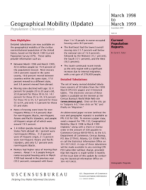
An official website of the United States government
Here’s how you know
Official websites use .gov
A .gov website belongs to an official government organization in the United States.
Secure .gov websites use HTTPS
A lock (
) or https:// means you’ve safely connected to the .gov website. Share sensitive information only on official, secure websites.
-
//
- Census.gov /
- Library /
- Publications /
- Geographical Mobility (Update): March 1998 to March 1999
Geographical Mobility (Update): March 1998 to March 1999
Geographical Mobility (Update): March 1998 to March 1999
Between March 1998 and March 1999, 42.6 million people (or 15.9 percent of the population) moved. Most movers (59.3 percent) stayed in the same county, 19.8 percent moved between counties within the same state, 17.6 percent moved to a different state, and 3.4 percent moved from abroad.
Moving rates declined with age: 32.4 percent for people 20 to 29 years old, 22.8 percent for those 30 to 34, 14.1 percent for those 35 to 44, 9.5 percent for those 45 to 54, 6.7 percent for those 55 to 64, and only 4.5 percent for those 65 and older.
Rates of moving were lower for non-Hispanic Whites (14.4 percent) than for non-Hispanic Blacks, non-Hispanic Asians and Pacific Islanders, and people of Hispanic origin–all of which were around 19.5 percent.
1.4 million people moved to the United States from abroad: 40.1 percent were non-Hispanic Whites, 31.6 percent were of Hispanic origin, 21.5 percent were non-Hispanic Asians and Pacific Islanders, and only 6.7 percent were non-Hispanic Blacks.
Renters had higher rates of moving than owners. About 1 in 3 people living in renter-occupied housing units in March 1999 had moved in the previous year (33.2 percent), compared with fewer than 1 in 10 people in owner-occupied housing units (8.3 percent).
The Northeast had the lowest overall moving rate (11.7 percent–well below the national rate of 15.9 percent), followed by the Midwest (15.1 percent), the South (17.1 percent), and the West (18.5 percent).
The South continued recent trends as the only region with a significant increase due to internal migration, with a net gain of 270,000 people.
Others in Series
Publication
Publication
Publication
Share
Related Information
Some content on this site is available in several different electronic formats. Some of the files may require a plug-in or additional software to view.
 Yes
Yes
 No
NoComments or suggestions?


Top


